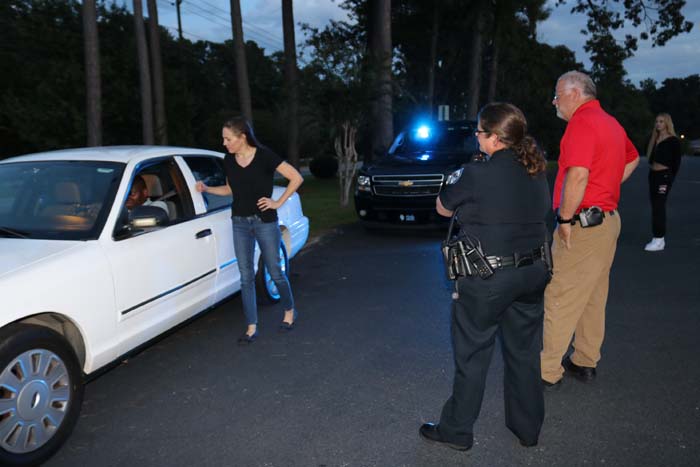Citizens get hands-on experience with TPD Equipment
Published 2:57 pm Wednesday, September 14, 2022

- An attendee from the Use of Force Summitt attempts to pull over a cadet during a traffic stop drill.
THOMASVILLE- On Thursday night, the City of Thomasville Police Department held the second of a three-week class known as the Citizen Use of Force Summit. The first class explained to citizens how and why law enforcement uses force and what one must do in order to avoid it. However, the second week allowed students the chance to step into the shoes of an officer and use the equipment necessary to detain individuals in fake scenarios.
Students were broken up into three different groups, allowing them a chance to experience every side of law enforcement.
The first group began by learning about Taser electronic control devices, before using them on a dummy.
The Taser electronic control devices used by TPD officers offer two options for each scenario.
Each Taser electronic control device has two probes, which are similar to fishing hooks.
“We want to get a big spread on each of the two probes,” Lieutenant Toby Knifer explained. “We want to affect as much of the muscle as we can, so if we get a big spread the body will lock up.”
When the body locks up due to being tased, officers refer to it as Neuromuscular Incapacitation or NMI.
An ideal spread is when one probe hits the top of the back muscle, while the other probe hits the calf.
However, a smaller spread still may be needed at times to control someone, if the first spread didn’t work. The Taser electronic control device allows a simple flick of the wrist in order for officers to switch back to a small spread.
While Knifer knows the Taser electronic control device may cause pain, he explained that the devices do not have electricity, which is a common misconception.
“It has a very low amount of amperage,” Knifer said.
The amperage in the devices is only .0004, which is very minute, but is just enough to let the body lock up, so it can’t fight back.
Knifer said in a volatile situation, he tells the subject “stop resisting or I’m going to tase you,” before ever letting the probes go. The Taser electronic control device then cycles for five seconds, before automatically cutting off.
If the first set of probes didn’t hit the subject or connect properly, another two can be sent from the existing device in use.
Following the use of a Taser electronic control device, officers can take out a card and download the date and time it was used, what the temperature was and the duration it was used for.
“It records everything, but video,” Knifer said.
Once the group had a feel for the Taser electronic control devices, they then moved into the scenarios room.
The scenarios room allowed students to respond to a virtual situation with a fake gun. The gun shot a laser at the subject, if the students decided to shoot in the scenario on display.
The first scenario was a homeowner, who walked into their backyard and found tools that were not theirs, located on their AC unit. Two men then approached claiming they were installing new roofs. Depending on the way the student responded to the two men, the men either walked away or pulled a gun on the homeowner, resulting in shots fired.
The second scenario had someone leaving a store, when a male popped up from behind their car door asking for change. The response to them asking for change, again depended on how the student responded. The male either ran away or ran toward them with a knife, resulting in shots fired once again.
The group finally went to their last station, which was a traffic stop. The students were required to see what it was like to walk up to a car and pull someone over, not knowing what may be lurking in the vehicle.
When an officer approaches a vehicle, they will first touch the trunk to make sure no one is in the vehicle and to also leave touch DNA in the event they were harmed during the stop. They then approach the driver or passenger’s side door.
The passenger’s side door has become more common, due to the fact it prevents officers from having to walk alongside busy traffic and shows a better visual of the inside of the vehicle.
Officers then stop prior to where the car door opens and ask the driver a few required questions.
Officers introduce themselves, say who they are with, the reason they have stopped the vehicle and ask the driver if there was a reason for the action.
They will then ask drivers for their license, before running it to make sure there are no active warrants.
“I like to check the information right near their vehicle, because I can still look at the driver,” said Officer Kim Dyke. “I may be checking the license of Ira, but the driver who I just got it from might be Frank.”
Once the license is run and officers decide if the driver will receive a ticket or not, they then halt traffic, allowing the driver back onto the road safely.
Students then ran through everything they had learned about a traffic stop, practicing with one of the cadets.
Following the final task of the night, TPD thanked students for retuning and encouraged everyone for returning for the final class next Thursday night at Southern Regional Technical College.





